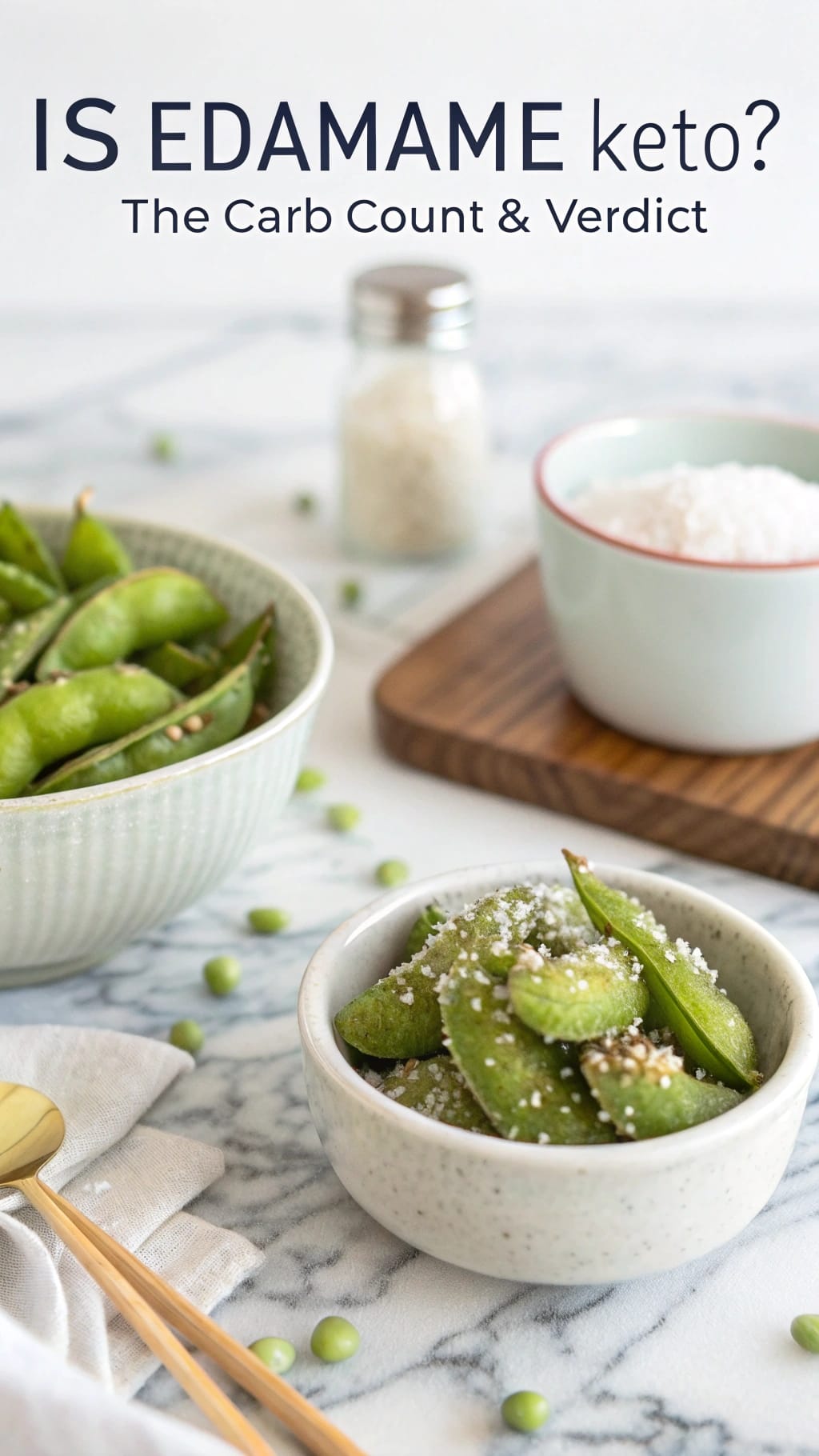Can You Eat Edamame On Keto? The Truth About Its Carbs
Love Edamame? Wondering if it Fits Your Keto Diet?
Edamame has gained massive popularity as a plant-based protein source in recent years. These vibrant green soybeans are a staple at Japanese restaurants and have found their way into countless health-conscious kitchens. But if you’re following a ketogenic diet, you might be questioning whether these little green pods deserve a place on your plate. After all, beans and legumes typically get the “avoid” label on most keto food lists.
Table of Contents
The Short Answer (and Why It Needs Explanation)
Generally, edamame is not considered very keto-friendly in typical serving sizes due to its carbohydrate content, but small amounts might fit for some individuals with more flexible low-carb approaches.
In this post, we’ll break down edamame’s carbohydrate profile, explain the concept of net carbs, examine how edamame fits (or doesn’t) into different keto approaches, and provide you with some truly keto-friendly alternatives to satisfy those crunchy, salty cravings.

Understanding is edamame keto: More Than Just Soybeans
Edamame are immature soybeans still in their pods, typically harvested before they harden. Unlike mature soybeans used for tofu or soy milk production, edamame beans have a sweeter taste and firmer texture.
These bright green beans are commonly served:
- Steamed and salted in their pods as an appetizer
- Shelled and added to salads, stir-fries, or grain bowls
- Processed into dips similar to hummus
- Roasted as a crunchy snack
While edamame offers impressive nutritional benefits—including complete protein, fiber, vitamins, and minerals—the critical question for keto followers centers around one thing: the carbohydrate content.
The Numbers Don’t Lie: Edamame Macronutrients
Before making dietary decisions, it’s essential to examine the nutritional facts. Let’s look at what one standard serving of edamame provides.
Carbohydrate Count per Serving
According to the USDA FoodData Central database, a 1-cup (155g) serving of shelled edamame contains [1]:
| Nutrient | Amount |
|---|---|
| Calories | 188 |
| Protein | 18.4g |
| Fat | 8.1g |
| Total Carbohydrates | 13.8g |
| Dietary Fiber | 8.1g |
| Net Carbs | 5.7g |
Net Carbs = Total Carbs – Dietary Fiber
This calculation is crucial for understanding edamame’s true impact on ketosis.
Why Net Carbs Matter on Keto
On a ketogenic diet, tracking net carbs rather than total carbs provides a more accurate picture of how foods affect your blood sugar and ketosis. Dietary fiber is a type of carbohydrate that your body cannot digest, so it doesn’t raise blood glucose levels or interfere with ketosis in the same way digestible carbs do [2].
For most people following a standard ketogenic diet, daily net carb intake is limited to 20-30 grams, though some more liberal low-carb approaches may allow up to 50 grams per day.
Learn more about calculating net carbs and their importance for ketosis
So, Can You Eat Edamame on Keto? It Depends…
Comparing Net Carbs to Keto Limits
When you’re limiting your daily net carbs to 20-30 grams, a single cup of edamame at 5.7g net carbs represents approximately 19-29% of your daily carb allowance. That’s a significant portion dedicated to a single food.
A research review published in the Journal of Nutrition and Metabolism suggests that staying under 50g of carbohydrates daily is necessary for most individuals to maintain nutritional ketosis [3]. With this context, edamame’s place in a ketogenic diet becomes clearer.
Strict Keto vs. Low-Carb / Moderate Approaches
Different approaches to keto and low-carb eating yield different answers about edamame’s compatibility:
For Strict Keto (20g net carbs or less): Fitting a full serving of edamame is challenging without sacrificing carbs from other nutritious foods like low-carb vegetables. A small portion (¼ cup) containing about 1.4g net carbs might be manageable occasionally.
For Moderate Low-Carb (30-50g net carbs): Those following a more liberal low-carb approach, particularly athletes or highly active individuals, may be able to include a moderate portion of edamame occasionally while maintaining their metabolic goals.
The Problem with Legumes/Soy on Some Keto Approaches
Beyond just carb count, there are other considerations that lead some keto adherents to avoid edamame entirely:
- Anti-nutrients: Soybeans contain phytates and lectins that some nutrition philosophies suggest may interfere with nutrient absorption [4].
- Phytoestrogens: The isoflavones in soy have a chemical structure similar to the hormone estrogen, which has led to debate about potential hormonal effects (though research remains inconclusive) [5].
- Strict Paleo-Keto Approach: Those following a paleo-influenced ketogenic diet typically exclude all legumes, including soybeans, based on evolutionary nutrition principles.

Discover why some people experience sugar cravings on keto
Craving a Salty, Snackable Green? Try These Keto Swaps!
If you’re missing that edamame experience but want to keep your carbs in check, consider these keto-friendly alternatives:
- Salted Cucumber Slices: At less than 2g net carbs per cup, cucumber provides that fresh crunch with minimal carb impact.
- Celery Sticks with Cream Cheese: Crisp, salty, and practically zero carb when paired with a high-fat dip.
- Olives: Green or black varieties offer similar snackability with roughly 0.5g net carbs per ounce.
- Roasted Salted Pumpkin Seeds (Pepitas): In moderation (¼ cup = approximately 2g net carbs), these provide crunch and valuable minerals.
- Pork Rinds: Zero carb and perfect for that salty craving.
- String Cheese or Homemade Cheese Crisps: Deliver protein and fat with minimal to no carbs.
Explore our complete guide to zero-carb snacks for keto and carnivore diets

Final Thoughts on Edamame and Your Keto Journey
While edamame offers impressive nutritional benefits—complete protein, fiber, and micronutrients—its carbohydrate content makes it generally unsuitable for strict ketogenic diets in standard portions.
For those following more moderate low-carb approaches or who have higher carb tolerances due to activity levels, small amounts of edamame might be incorporated occasionally without disrupting metabolic goals. However, careful tracking is essential.
Remember that successful keto eating is about making informed choices that align with your personal carb tolerance and health goals. For many, focusing on truly low-carb vegetables, quality animal proteins, and healthy fats provides an easier path to maintaining ketosis than trying to fit in borderline foods like edamame.
What are your thoughts on edamame? Have you found ways to include small amounts while staying in ketosis, or do you prefer to avoid it entirely? Share your experience in the comments!
If you’re looking for truly keto-friendly plant options, check out our Complete Keto Food List and discover Why Some People Struggle With Weight Loss on Keto.
References:
[1] U.S. Department of Agriculture, Agricultural Research Service. FoodData Central, 2019. “Edamame, shelled.”
[2] Westman EC, et al. “Low-carbohydrate nutrition and metabolism.” American Journal of Clinical Nutrition, 2007; 86(2):276-284.
[3] Masood W, Uppaluri KR. “Ketogenic Diet.” StatPearls [Internet]. Treasure Island (FL): StatPearls Publishing; 2021.
[4] Petroski W, Minich DM. “Is There Such a Thing as ‘Anti-Nutrients’? A Narrative Review of Perceived Problematic Plant Compounds.” Nutrients. 2020;12(10):2929.
[5] Messina M. “Soy and Health Update: Evaluation of the Clinical and Epidemiologic Literature.” Nutrients. 2016;8(12):754.
Disclaimer: This article is for informational purposes only and is not intended as medical advice. Always consult with a healthcare professional before making significant changes to your diet, especially if you have underlying health conditions.
Enjoy, Review – We Value Your Opinion!
There are no reviews yet. Be the first one to write one.

